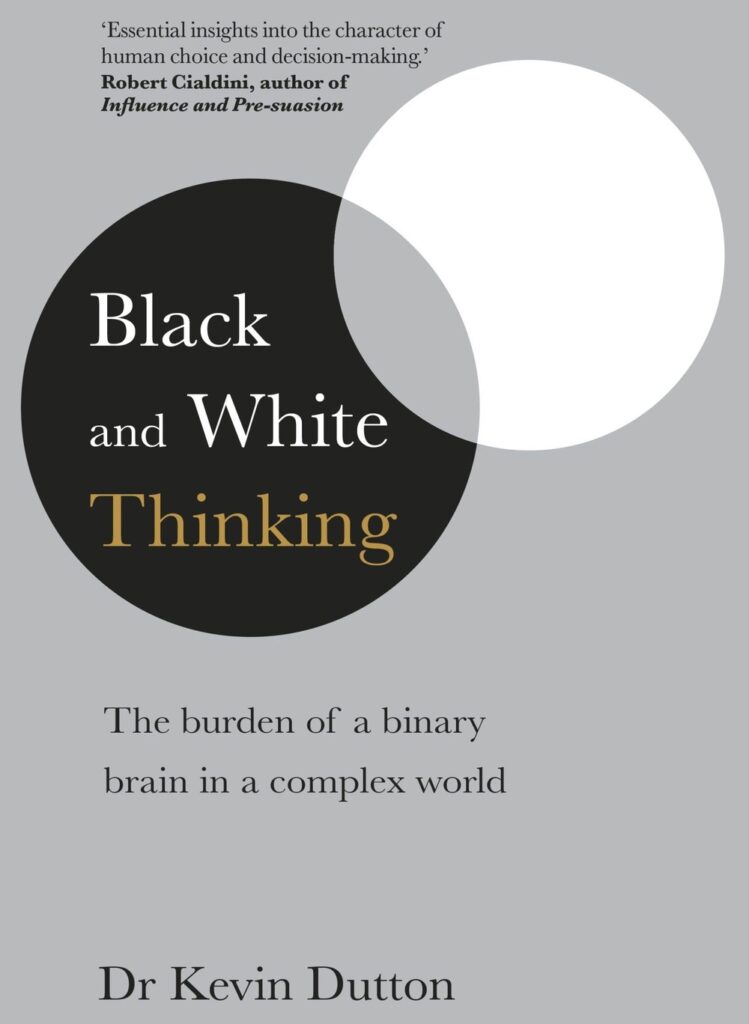Sharing my learnings from the book, Black and White Thinking by Kevin Dutton
Black and White Thinking by Kevin Dutton
In Black-and-White Thinking, the renowned psychologist Kevin Dutton pulls back the curtains of the mind to reveal a new way of thinking about a problem as old as humanity itself. While our instinct for categorization often leads us astray, encouraging polarization, rigid thinking, and sometimes outright denialism, it is an essential component of the mental machinery we use to make sense of the world. Simply put, unless we perceived our environment as a chessboard, our brains wouldn’t be able to play the game.
Using the latest advances in psychology, neuroscience, and evolutionary biology, Dutton shows how we can optimize our tendency to categorize and fine-tune our minds to avoid the pitfalls of too little, and too much, complexity. He reveals the enduring importance of three “super categories”—fight or flight, us versus them, and right or wrong—and argues that they remain essential to not only convincing others to change their minds but to changing the world for the better. Black-and-White Thinking is a scientifically informed wake-up call for an era of increasing extremism and a thought-provoking, uplifting guide to training our gray matter to see that gray really does matter.

- A multitude of categories exists all around us – in movies, music, and even gender. The key to navigating the world is in finding a balance between the two – neither an excess nor dearth of categories.
- When we’re born, the world is a confusing swirl of sensations that can be difficult to make sense of. That’s where categorization comes in. Categories help us sort the mess into more easily understood, meaningful piles.
- categorization is still very important today. But it was even more so for our ancient ancestors.
- We needed categories to help us recognize survival threats. And our brains gave us the binary distinction of fight versus flight.
- Next, evolution equipped us with two other major binaries: us versus them and right versus wrong. Both of these were meant to increase social cohesion.
- Categorization helped our ancestors survive. But in the modern world, it frequently gets us into trouble
- Gray areas are everywhere – and they can be tough to navigate. Ignoring gray areas can have dire consequences.
- psychologists call an underinclusive style of categorization. This means you create more categories in your head, but you include fewer items within each category. Hoarders often do this. They put each item into its own special category. That makes everything seem more unique, and harder to discard.
- People with an overinclusive style of categorization define categories broadly, with many items under each one. people with overinclusive styles may be more likely to engage in stereotyping.
- So, what do we do about this? The key is all about balance. You need to know when to look at the big picture and when to zoom in on the details. Sometimes, of course, it’s entirely appropriate to categorize things into black and white. But when it comes to more complex issues, a wider view is necessary.
- People lie on a spectrum from cognitive closure to cognitive complexity.
- cognitive closure. People with this characteristic desire certainty. They need to see things in black-and-white, open-and-shut terms.
- cognitive complexity. These are people who are highly tolerant of ambiguity. They see shades of gray in everything and tend to make decisions slowly.
- It’s important to note that neither cognitive complexity nor cognitive closure is strictly good or bad.
- Tribalism distorts our perception of reality.
- Extreme language encourages extreme thought. And this can have real-world consequences. The language we use has real effects on ourselves, others, and the world at large.
- A frame is a particular way of talking about something – an angle or a lens through which to view an issue. Framing is a powerful tool of persuasion.
- three major frames underpin every persuasive argument.
- fight versus flight
- us versus them
- right versus wrong
- When you use one or more of these three, you engage in what the author terms supersuasion.
- Frames can be ultrapersuasive – but you can still avoid falling prey to their influence. The best way to do so is by paying close attention to the categories hidden in people’s arguments. That way, you can learn to spot and deconstruct the black-and-white thinking hidden within.


Leave a Reply